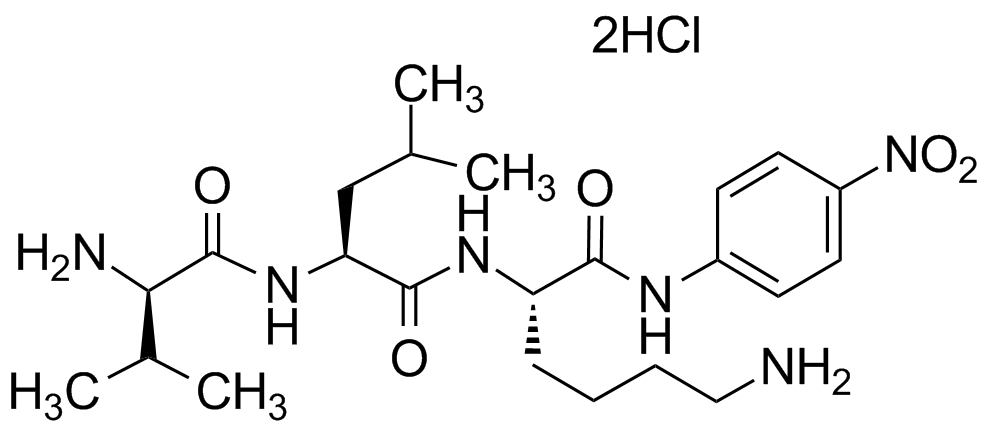H-D-Val-Leu-Lys-pNA . 2HCl
| Code | Size | Price |
|---|
| AG-CP3-0042-M005 | 5 mg | £60.00 |
Quantity:
| AG-CP3-0042-M025 | 25 mg | £210.00 |
Quantity:
Prices exclude any Taxes / VAT
Overview
Regulatory Status: RUO
Shipping:
AMBIENT
Storage:
Short Term: +4°C, Long Term: -20°C
Images
Documents
Further Information
Alternate Names/Synonyms:
H-D-Valyl-L-leucyl-L-lysine-p-Nitroanilide . 2HCl; vLK-pNA
Appearance:
White to off-white solid.
CAS:
62354-43-2
EClass:
32160000
Form (Short):
liquid
GHS Symbol:
GHS07,GHS08
Handling Advice:
Keep cool and dry.
Hazards:
H302 + H312 + H332, H315, H319, H335, H361
InChi:
InChI=1S/C23H38N6O5.2ClH/c1-14(2)13-19(28-23(32)20(25)15(3)4)22(31)27-18(7-5-6-12-24)21(30)26-16-8-10-17(11-9-16)29(33)34;;/h8-11,14-15,18-20H,5-7,12-13,24-25H2,1-4H3,(H,26,30)(H,27,31)(H,28,32);2*1H/t18-,19-,20+;;/m0./s1
InChiKey:
VESQMNNSPPEOSZ-ZLARAOTRSA-N
Long Description:
Chemical. CAS: 62354-43-2. Formula: C23H38N6O5 . 2HCl. MW: 478.6 . 72.9. D-Val-Leu-Lys-p-nitroanilide is a selective colorimetric substrate for plasmin used to determine the formation of plasmin from plasminogen in amidolytic activity assays and plasminogen activating assays. Plasmin is a plasma serine protease whose main role is to dissolve fibrin blood clots. After cleavage by plasmin the protease activity is quantified by the release of p-nitroaniline (pNA) from the substrate. The rate of pNA formation, e.g. the increase in absorbance per second at 405 nm, is proportional to the enzymatic activity.
MDL:
MFCD00077899
Molecular Formula:
C23H38N6O5 . 2HCl
Molecular Weight:
478.6 . 72.9
Package Type:
Plastic Vial
Precautions:
P280, P301 + P312, P302 + P352 + P312, P304 + P340 + P312, P305 + P351 + P338, P308 + P313
Product Description:
D-Val-Leu-Lys-p-nitroanilide is a selective colorimetric substrate for plasmin used to determine the formation of plasmin from plasminogen in amidolytic activity assays and plasminogen activating assays. Plasmin is a plasma serine protease whose main role is to dissolve fibrin blood clots. After cleavage by plasmin the protease activity is quantified by the release of p-nitroaniline (pNA) from the substrate. The rate of pNA formation, e.g. the increase in absorbance per second at 405 nm, is proportional to the enzymatic activity.
Purity:
>98% (HPLC)
Sequence:
D-Val-Leu-Lys-p-Nitroanilide
Signal word:
Warning
SMILES:
[H]Cl.[H]Cl.O=C(N[C@@H](CCCCN)C(NC1=CC=C([N+]([O-])=O)C=C1)=O)[C@H](CC(C)C)NC([C@@H](C(C)C)N)=O
Solubility Chemicals:
Soluble in water (50mg/ml).
Transportation:
Non-hazardous
UNSPSC Category:
Biochemical Reagents
UNSPSC Number:
12352200
Use & Stability:
Stable for at least 1 year after receipt when stored at -20°C.
References
Chromogenic substrates: Scan. J. Clin. Lab. Invest. 42, 15 (1982) | Plasminogen Activation in Diabetes Mellitus: M. Geiger & B.R. Binder; J. Biol. Chem. 259, 2976 (1984) | Purification and characterization of a fibrinolytic enzyme of Bacillus subtilis DC33, isolated from Chinese traditional Douchi: C.T. Wang, et al.; J. Ind. Microbiol. Biotechnol. 33, 750 (2006) | Regulation of plasminogen activator activity and expression by cyclic mechanical stress in rat mandibular condylar chondrocytes: W. Chen, et al.; Mol. Med. Rep. 8, 1155 (2013) | Purifcation and characterization of a novel, highly potent fbrinolytic enzyme from Bacillus subtilis DC27 screened from Douchi, a traditional Chinese fermented soybean food: Y. Hu, et al.; Sci. Rep. 9, 9235 (2019) | Heat-Treatments Affect Protease Activities and Peptide Profiles of Ruminants' Milk: J.A.S. Leite, et al.; Front. Nutr. 8, 626475 (2021)



